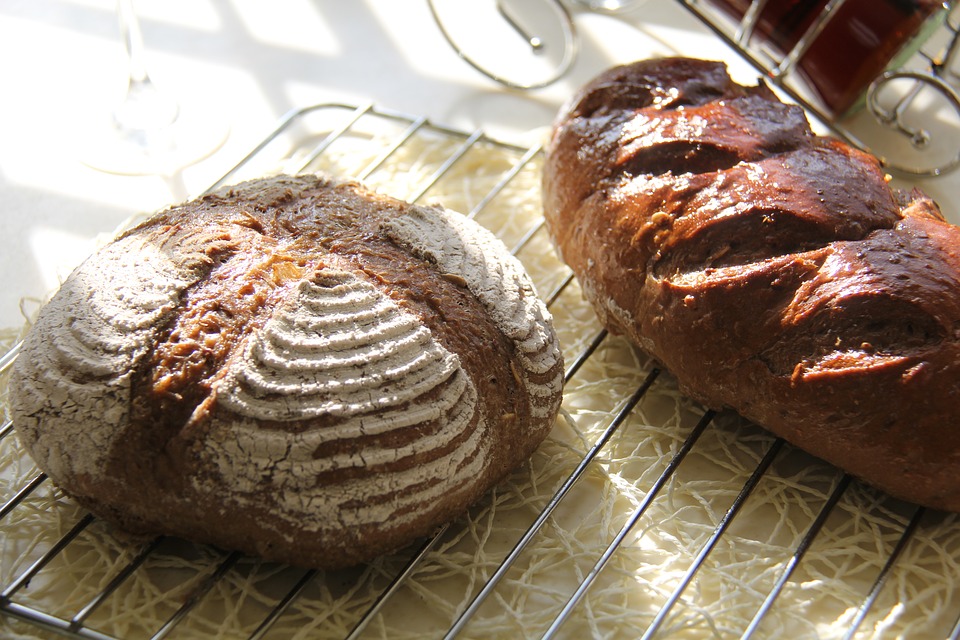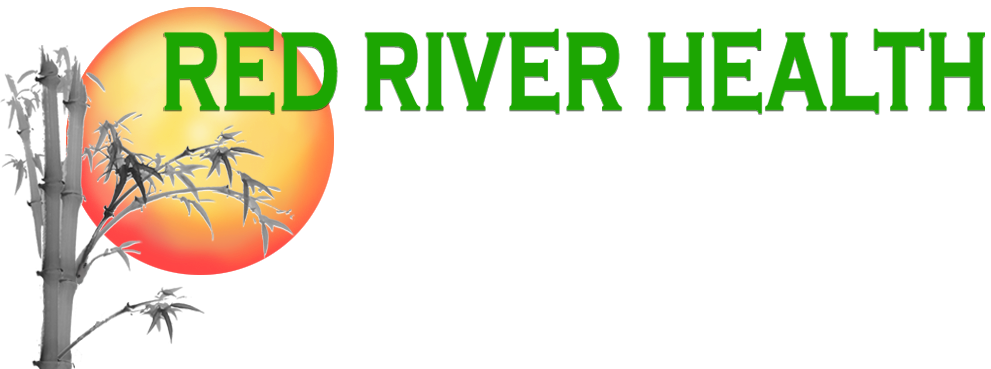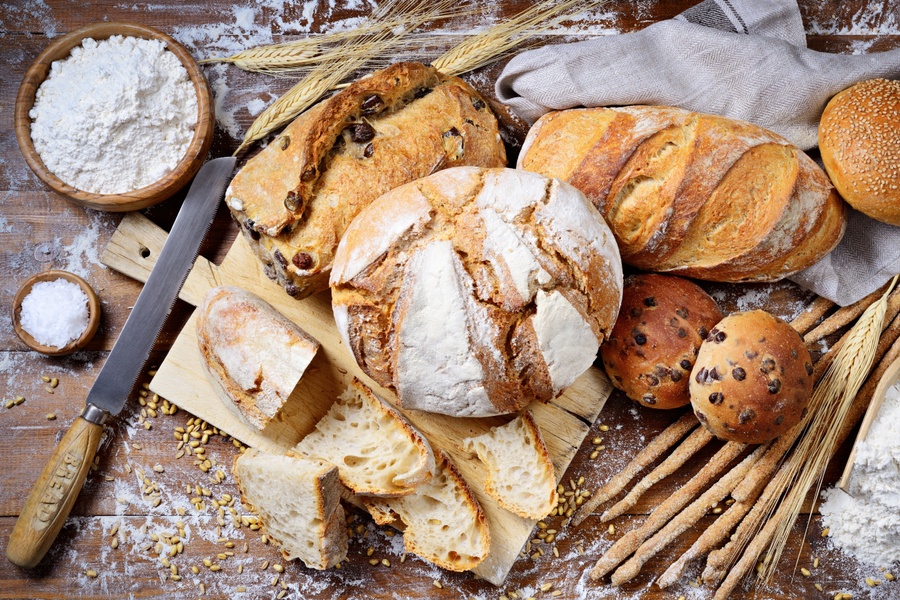Robert Angotti, Lic. Ac., Herbalist
A look at the effect of wheat on our health, and why it’s happening.
I love bread! When I moved from the midwest to the Bay Area, the thing that I loved the most were the exceptional, European style breads. In fact, I spent 7 or 8 years working at a bakery in Berkeley. We made breads similar to what you see above, and I lived off the stuff.
I was spoiled by fresh breads warm from the ovens. I tore pieces and dipped them in olive oil, salt and pepper as I worked. I’m certain however that my daily consumption of bread, combined with prior years of exposure to refined grains in the form of cereals, pastas, crackers, pastries and more, created a norm of chronic inflammation in my system.
In fact, wheat is probably one of the most influential foods on our health. But for most of us, that means we really shouldn’t eat it, or at least much of it. What happened?
Medical perspectives on wheat
The Traditional Chinese Medical (TCM) view on wheat is that it’s slightly cool and sweet. These attributes describe it’s medicinal and nutritional actions. The cooling attribute speaks to wheat’s ability to clear heat (infection and inflammation). The sweet attribute speaks to wheat’s ability to nourish the body and generate qi. Wheat has been a healing food for centuries. The cultivation of wheat and other grains brought forward civilization and have lead to the modern industrial era. However, like anything, too much wheat consumption can be a cause for dysfunction.
In TCM pathology, too much wheat consumption weakens the spleen qi. Our ability to “transform and transport” the nutritive essence of digestion relies upon strong spleen qi. Critically, failure in this “transformation” process results in the accumulation of impure, lingering substances. We call these substances dampness, and in more severe concentrations we call it phlegm.
I have often pondered what dampness and phlegm look like at a cellular level. Patients with these issues often suffer with things like, frequent sinus problems, or chronic phlegm in the throat. They may have more frequent, watery stools, or swelling of the legs, or gurgling sounds in the abdomen. These patients may also have more cysts apparent on the body and difficulty losing weight or a cravings for sweets. Most patients can usually see the meaning of dampness and phlegm when framed this way. Often, they just feel heavy and damp.
Dampness in the cells
I consider dampness, and specifically the effect of wheat consumption, to be even more pernicious than the outward manifestations. I have imagined dampness to be disruptive at a molecular level, making the fluids of our cellular matrix gummy and viscous, gradually slowing down cellular functions. At this level dampness disrupts the essential mechanisms for life.
I gathered more insight into this when studying the cellular dynamics of aging. Dr. David Sinclair was describing the power of proteins in his book “Lifespan”. He was explaining how at every instant hundreds of thousands of molecular interactions are occurring in our bodes to sustain life. Proteins are the essence of that molecular mix and yet, he went on to say that sugars act on the proteins to gum up that process. Too much sugar in the body essentially “caramelizes” the proteins. That image has stuck with me as a way of appreciating the damaging effect of sugar and the formation of dampness. This process is called gylcation and I have found interesting information about it in relation to aging.
Meanwhile however, I was concerned about what might have changed with wheat to make it more disruptive. How could something that nourished our species beyond sparse hunter gather populations and into large civilizations be so problematic today nutritionally.

Too much of a good thing
A simple explanation for the problem with wheat is the refining of the grain. We strip much of the nutritional essence off the kernel at processing. Interestingly, removing the brown parts and leaving the white parts of the seed also remove some of the bitter flavor. In TCM, the bitter flavor helps to drain dampness from the body. Having both the yin and the yang in the plant food is more healthy and balanced.
Another easy answer to the wheat problem is the general overabundance of sugar in our diet. Enough said there…well, maybe not. Start at any location in the city and see how far you have to walk to get a “food” with sugar. Start in that same location and see how far you would have to go to get a bowl of slightly bitter greens.
Still one more answer to the “what happened to wheat” question falls less on wheat itself and more on the society in general. Frankly, we are over-nourished and under exercised. As hunter gatherers we spent hours in physical pursuit of food. Today we drive up to it, and it usually has some form of refined, sweetened wheat in it.

4 problems with modern agricultural wheat
For me, it was Dr. Mark Hyman who best articulated an answer to the question of “what happened to wheat?”. In an interview with Peter Attia, Mr. Hyman succinctly outlined the problem and provided some solutions. Below I have included his four concerns with modern wheat production. I have also added some relevant research on the topics where I could find it.
1. Dr. Hyman correlates many of the modern medical challenges associated with wheat to the focus on yield production and the reliance on fewer and fewer plant strains in modern agriculture. Dwarf wheat is the main strain produced by our farmers. This strain has been hybridized for drought resistance and starch production. However starches are sugars and the primary wheat grown in the United States produces high levels of the starch amylopectin. This particular starch raises the blood sugar like normal granulated white sugar. As we know, too much sugar leads to dampness, thereby gumming up cell functions.
2. Another problem with the modern breeding method of wheat is the formation of extra proteins. These proteins enhance the gluten structure of the wheat, but they can agitate many people. Gliadin proteins are found in wheat and they frequently lead to more inflammation. This inflammation disrupts the digestive system and leads to chronic illnesses like leaky gut syndrome. In other words, these excessive proteins weaken the spleen qi and lead to the accumulation of dampness.
The further I go here in this essay, the more I fear insulting my farmer friends. Let me be clear, I have great admiration for farmers. Through modern farming, we have lifted millions out of famine. There are many consequences as well however. So far, what I have outlined are medical complications associated with a focus on yield instead of a focus on health. But in my opinion, no farmer is to blame for that. We have created a no win situation for the modern farmer who is often perpetually in debt, and bond by contracts to corporate seed companies. Healing the food system is as much about healing the modern farm system as it is the food itself. Nevertheless, that food system does have some issues. The next one Dr. Hyman addressed is herbicides.
3. The herbicide Glyphosate has been extremely valuable in modern agriculture. I farmed organically last year, and spent countless hours managing weeds. There is no way a modern farm can invest in human bodies weeding fields. The use of glyphosate seems controversial, however the research on its relationship to cancer needs to be looked at. Moreover, according to Dr. Hyman, in the case of wheat, glyphosate is often applied at harvest to defoliate the plants. This late application moves glyphosate much more readily into the food. Our modern cheerios contain more glyphosate than either vitamins A or D.
4. Finally, calcium propionate is preservative added to wheat during processing. This preservative has been shown to lead to neurological toxicity and subsequent “irritability, restlessness, inattention and sleep disturbance” in children. I think we’re having enough trouble keeping the attention of our youth right now. No doubt the morning cereal isn’t helping.
Giving up bread
No, I’m not giving up bread. However, I have restricted wheat in my diet quite a bit. Dr. Hyman recommends considering heirloom wheat varieties, and I plan to try that before giving up baking bread. I’ve had patients tell me they have success with some other flour sources. Feel free to add those experiences in the comments below. But, as a former baker, and an occasional weekend baker, I can’t see those flours producing the breads I love. I am more likely to get ahold of some kernza wheat seed and try growing that at the farm. When I do, I’ll let you know!
We love your comments! Please understand that they may be published publicly. If you would like us to keep your comments private, please let us know in the comment itself. You are also welcome to contact the clinic directly by email. Thank you!




Great article! I love bread too. Over the past few months I have started baking my own bread and using alternative flours including almond and coconut. The breads have turned out nice. I will continue to experiment because I don’t want to give up bread.
Robert,
Thank you for the article. I found it interesting and informative, finally addressing an issue that many are aware of, but failed to address in our daily lives. Being born into a German family, fresh baked bread was a staple, as were homemade noodles, and all of the pastries that Germans are so fond of. As an adult, I battled with inflammation in my hands and ankles, but could never figure out why. Doctors were quick to point out that my father had major issues with heart and kidney function, and that inflammation was one of the precursors of both. Not one medical person ever questioned my diet, or my ingestion of carbohydrates including wheat and sugar. I resigned myself that constant inflammation was a reality. This past year, after being introduced to KETO, I started on it, and much to my delight, it worked! I lost weight and the inflammation in my legs and hands went down. With acupuncture treatments from you, I began to feel the best i had in years. Thank you. It is so sad that our American physicians are taught to cut and/or prescribe, rather than look for and treat the root of the problem.
Thank you, Robert! The food we eat plays such an important role in our health. I appreciate the support you put out for our agricultural producers. You presented many salient points about production and use of wheat in the modern diet. As a former professional baker as well, I will also add this. In past times sourdough and other fermentation methods were entirely utilized for raising the bread as opposed to modern yeast strains used by mass production which produce a much quicker result. A lengthy fermentation changes the composition of the final bread product, compared to a dough risen with commercial yeast. Some individuals find that eating sourdough bread helps. It wasn’t enough to help me and my neurological issues, and I follow a gluten-free diet. I still make sourdough bread for the rest of my family, utilize whole grains and avoid commercial yeast when possible. I hope these kinds of postings will continue to open discussion about our food supply.
Thanks Ruth. Dr. Hyman does reference the potential value in slower fermentation times but I haven’t spent time looking for clinical research on use of yeasted breads versus sourdough fermented breads. Generally, I think eating foods as have been consumed by our ancestors for hundreds of years, versus foods as they are being made over the last 50-60 years of is good rule of thumb. Some have suggested (Michael Pollan I think, author of “Food Rules: An Eater’s Manual”) the following guideline with food; “If your great grandmother wouldn’t recognize it, don’t eat it.”
Robert, I love your newsletters and appreciate the time you put into them!
I too love bread (and sugar) unfortunately. I know about the problems our wheat of today can cause and have read about ‘heirloom’ wheat. I’m just curious, is that wheat gone forever or is it grown somewhere in the world? Does that have something to do with the kernza wheat seeds you reference?
Hi Cat. Thanks so much for your support. I really hope to keep building resources on the site that support our health. Your feedback and willingness to share this information are both big contributions. You ask great questions about the suggestions I hinted at in the article. The kernza wheat is really interesting to me. Unlike modern dwarf wheat, it is a perennial, meaning it grows back and produces yearly. I am really attracted to that option because it is consistent with something known as “regenerative” agriculture. I look forward to writing more about that in the future as I am trying to introduce the practice at the hemp farm.
I have looked for some of the heirloom wheat varieties. Dr. Hyman mentioned einkorn wheat which I have found online but remains pretty expensive. My brother found this resource: https://www.janiesmill.com. I might consider ordering bulk or getting a retail account with them if my clients are interested. They have a few different heirloom wheat varieties available.